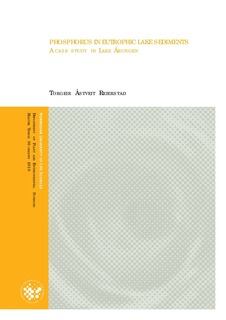PHOSPHORUS IN EUTROPHIC LAKE SEDIMENTS. A case study in Lake Årungen
Master thesis
Permanent lenke
http://hdl.handle.net/11250/189296Utgivelsesdato
2010-10-29Metadata
Vis full innførselSamlinger
- Master's theses (IPM) [204]
Sammendrag
Abstract
Lake Årungen has since last world war become a highly eutrophic lake because of increased supply of
phosphorus from sewage and agriculture. Despite high effort to reduce the phosphorus loading through
the last 30 years, the lake is still highly eutrophic, and with frequent algae blooms. The lake is located
in Akershus County in southeast Norway. The lake surface area is 1.2km2 and drains an area of 52km2.
The catchment consist of mainly marine clay and some glacial tills. More than 50% of the area is
agriculture fields, mainly with cereal production, and agriculture is the main contributor to the
phosphorus load today.
In early spring 2009, while the lake still was ice-covered, 122 sediment cores were collected from the
lake. The cores were sectioned in to layers, one from 0 to 2.5cm and one from 2.5 to 5cm. This is one
of four master these conducted on these sediment samples, and together they gives the most complete
mapping of surface sediments ever conducted in Norway. I have in this thesis analysed the sediment
samples for tot P, organic- and inorganic P, oxalate extractable Al, Fe and P, and P-AL. In addition the
sediment samples were analysed for carbon, nitrogen, sulphur, metals and mineralogy in the three
other theses.
All the parameters showed increasing concentrations towards greater water depth. This was also a
pattern that was reported for clay, total iron and total aluminium, which is known to be important for
the adsorption of phosphorus. There were also a general trend that the phosphorus concentrations was
highest in the upper layer, but the storage was highest in the lower, mainly due to higher dry matter
content.
The sediment overall contains higher concentrations of all measured fractions of phosphorus compared
with agriculture soil in the drainage area. The increase was highest for the inorganic phosphorus
fractions, which increased as much as 80% from field to sediment, while P-AL only shows a slightly
increase. The phosphorus sorption degree decreased from field to sediment which implies a stronger
binding of phosphorus in the sediment than in the soil.
The annual accumulation of sediments in Lake Årungen were estimated to be 1.5*106kg dw, which
contains 3000kg phosphorus. The estimated accumulation and measured flux in the outlet gave a total
load of 2*106kg dry matter and 5700kg phosphorus. This gives a retention factor of 0.5 for phosphorus
and 0.75 for dry matter in the lake. Sammendrag
Årungen har siden siste verdenskrig blitt en sterkt eutrof innsjø på grunn av økt tilførsel av fosfor fra
kloakk og landbruk. Til tross for høy innsats for å redusere fosfor belasting gjennom de siste 30 årene,
er innsjøen fortsatt sterkt eutrof, og med hyppige alge oppblomstringer. Årungen ligger i Akershus
fylke i sørøst Norge, i et område med høy landbruks aktivitet, hovedsakelig med kornproduksjon.
Innsjøen er 1.2km2 og har et nedslagsfelt på 52km2, som består av hovedsakelig marin leire og noen
isbreer kasser. Mer enn 50% av arealet er jordbruksområder, og jordbruk er den største bidragsyteren
til fosfor belastningen i dag.
Tidlig våren 2009, mens innsjøen fortsatt var is dekket, ble 122 sedimentkjerner hentet inn fra sjøen.
Kjernene ble delt i to lag, fra 0 til 2,5cm og fra 2.5 til 5cm. Dette er en av fire masteroppgaver som er
utført på disse sedimentprøvene, og disse oppgaven tilsammen gir den mest komplette kartlegging av
overflaten sedimenter som noen sinne er gjennomført i Norge. Jeg har i denne avhandlingen analysert
sedimentprøvene for total fosfor, organisk og uorganisk fosfor, oxalate extrherbart Al, Fe og P, og PAL.
I tillegg er sedimentet gjennom de andre masteroppgavene analysert for karbon, nitrogen, svovel,
metaller og mineralogi.
Alle analyserte fraksjoner av fosfor viste økende konsentrasjoner ved økende dyp. Dette er et mønster
som også er rapportert for leire, total jern og total aluminium, som er kjent for å være viktig for
binding av fosfor. Det er også en generell trend at konsentrasjonene av fosfor er høyere i øvre enn i
nedre laget, men at lagret mengde er størst i det nedre laget, hovedsakelig som en følge av høyere
tørstoff innhold.
Sedimentet inneholder generellt høyere konsentrasjoner av alle mål fraksjoner av fosfor sammenlignet
med jordbruksjord i nedslagsfelt. Økningen er størst for uorganisk fosfor som økte så mye som 80%
fra jord til sediment, mens P-AL bare viser en svak økning. Fosfor metningsgraden synker fra jorde til
sediment, noe som innebærer en sterkere binding av fosfor i sedimentet enn i jorda.
Den årlige akkumulering av sedimenter i innsjøen Årungen er estimert til 1,5 * 106 kg tørrstoff, som
inneholder 3000 kg fosfor. Den estimerte akkumulering og målt fluks i utløpet gir en total tilførsel på
2 * 106 kg tørrstoff og 5700 kg fosfor. Dette gir en retensjons faktor på 0,5 for fosfor og 0,75 for
tørrstoff i innsjøen.
